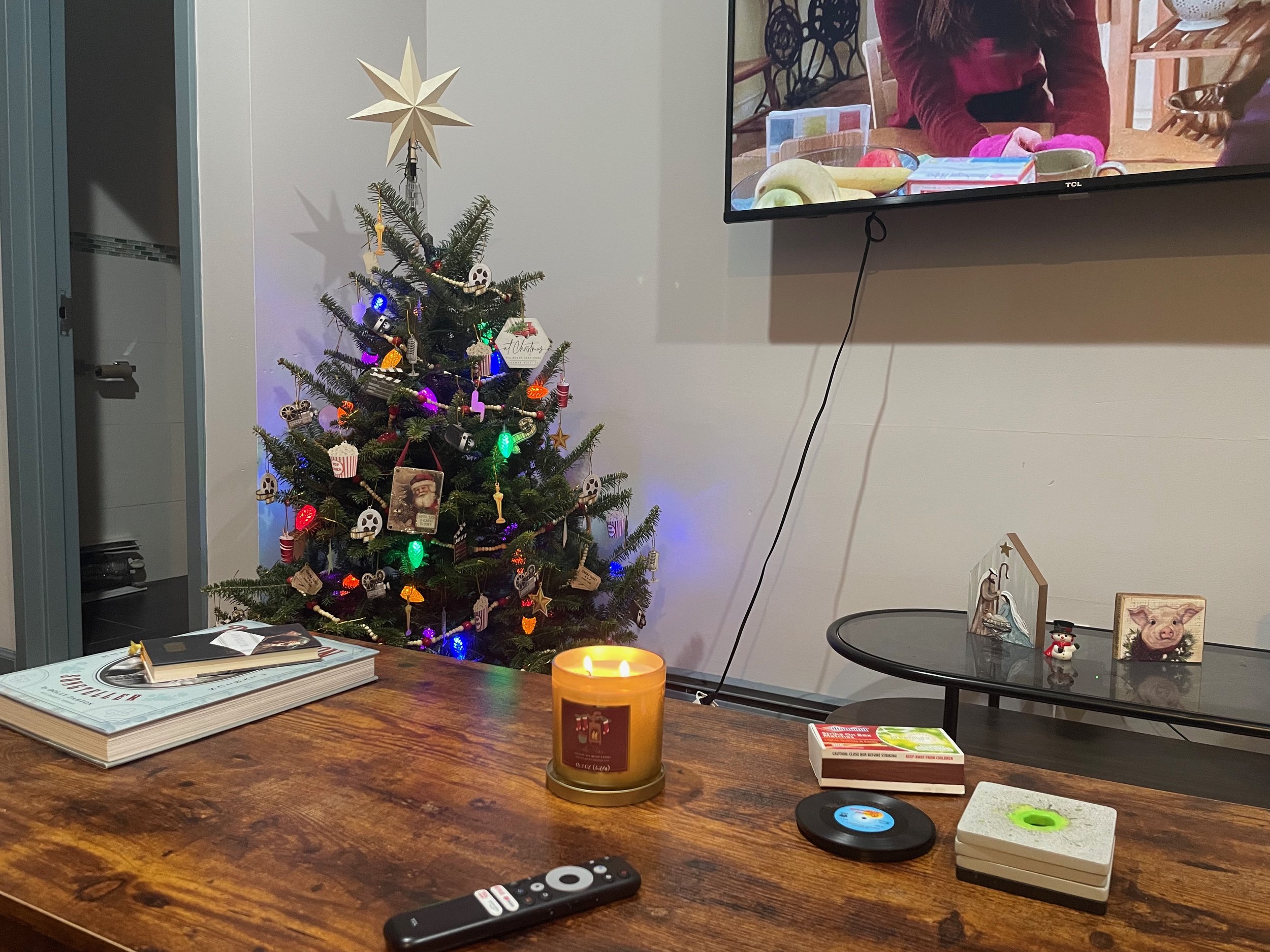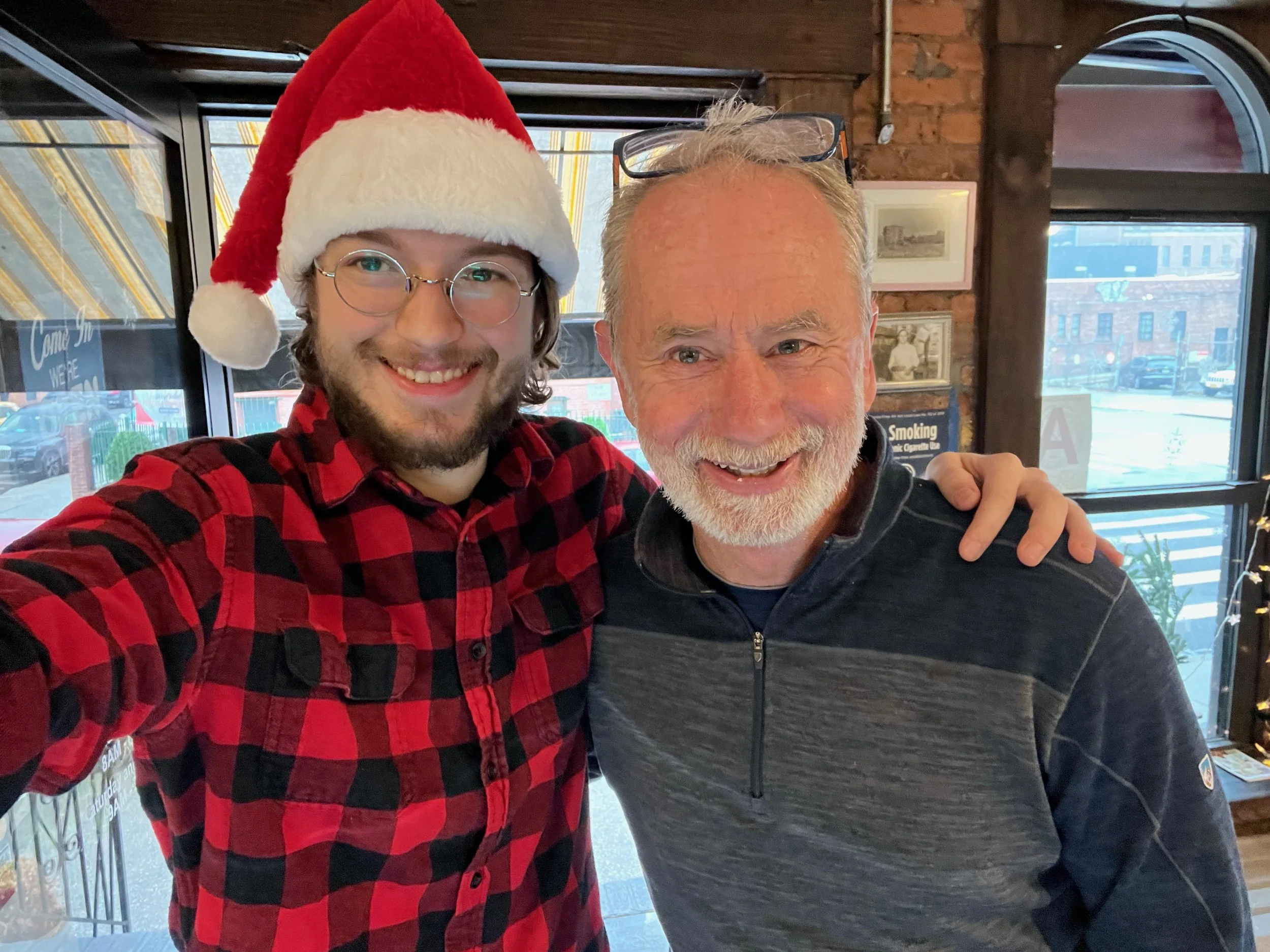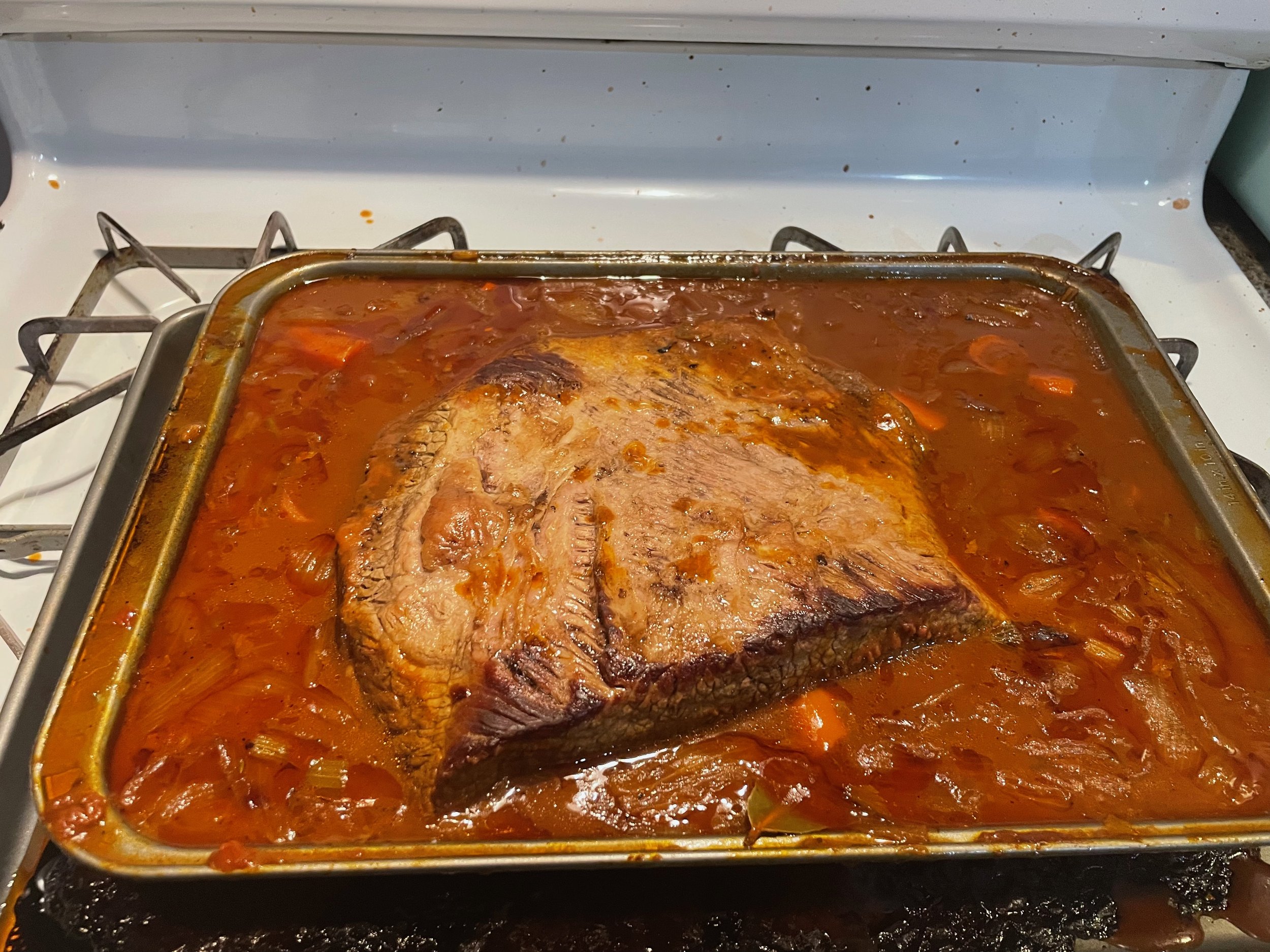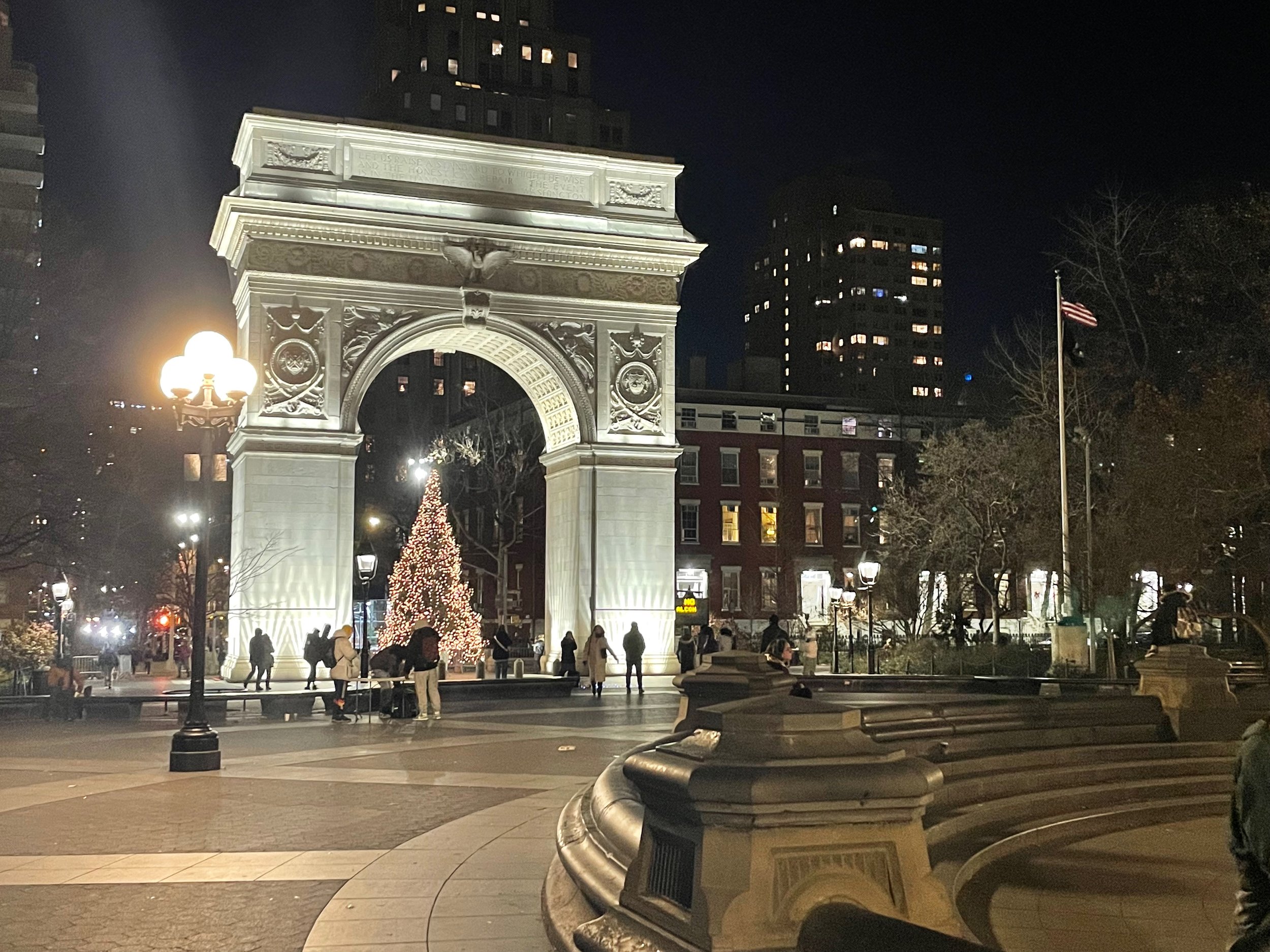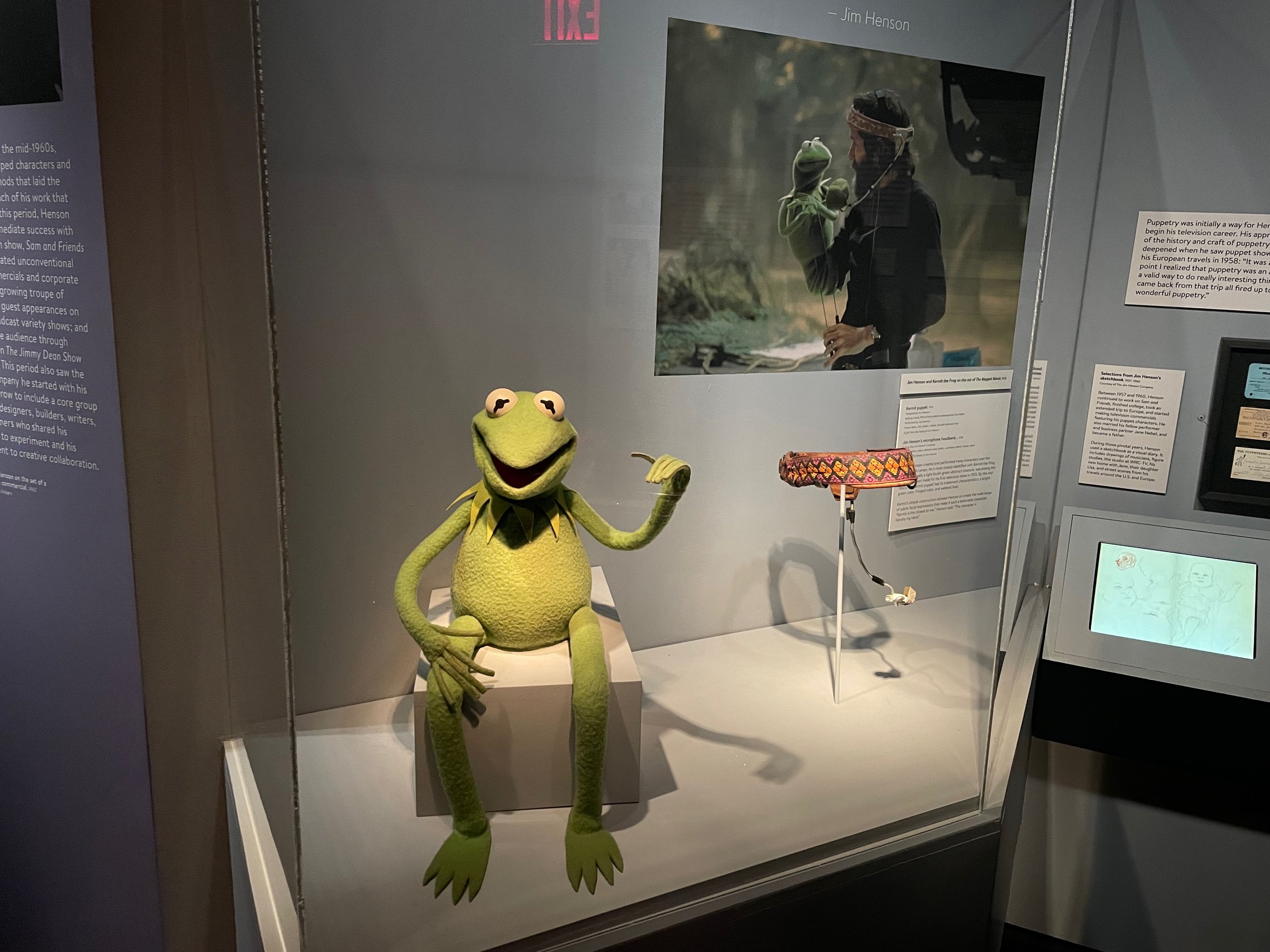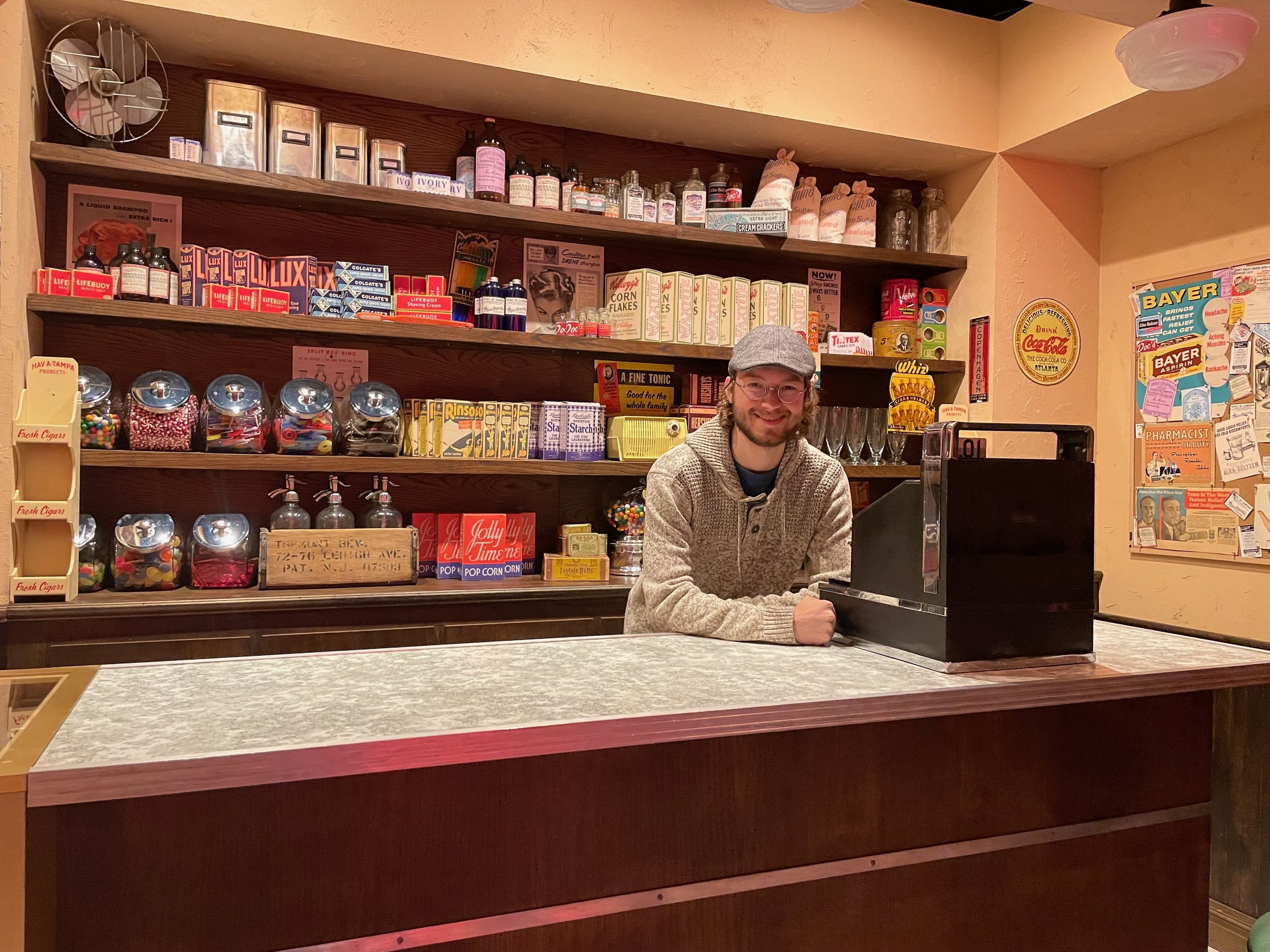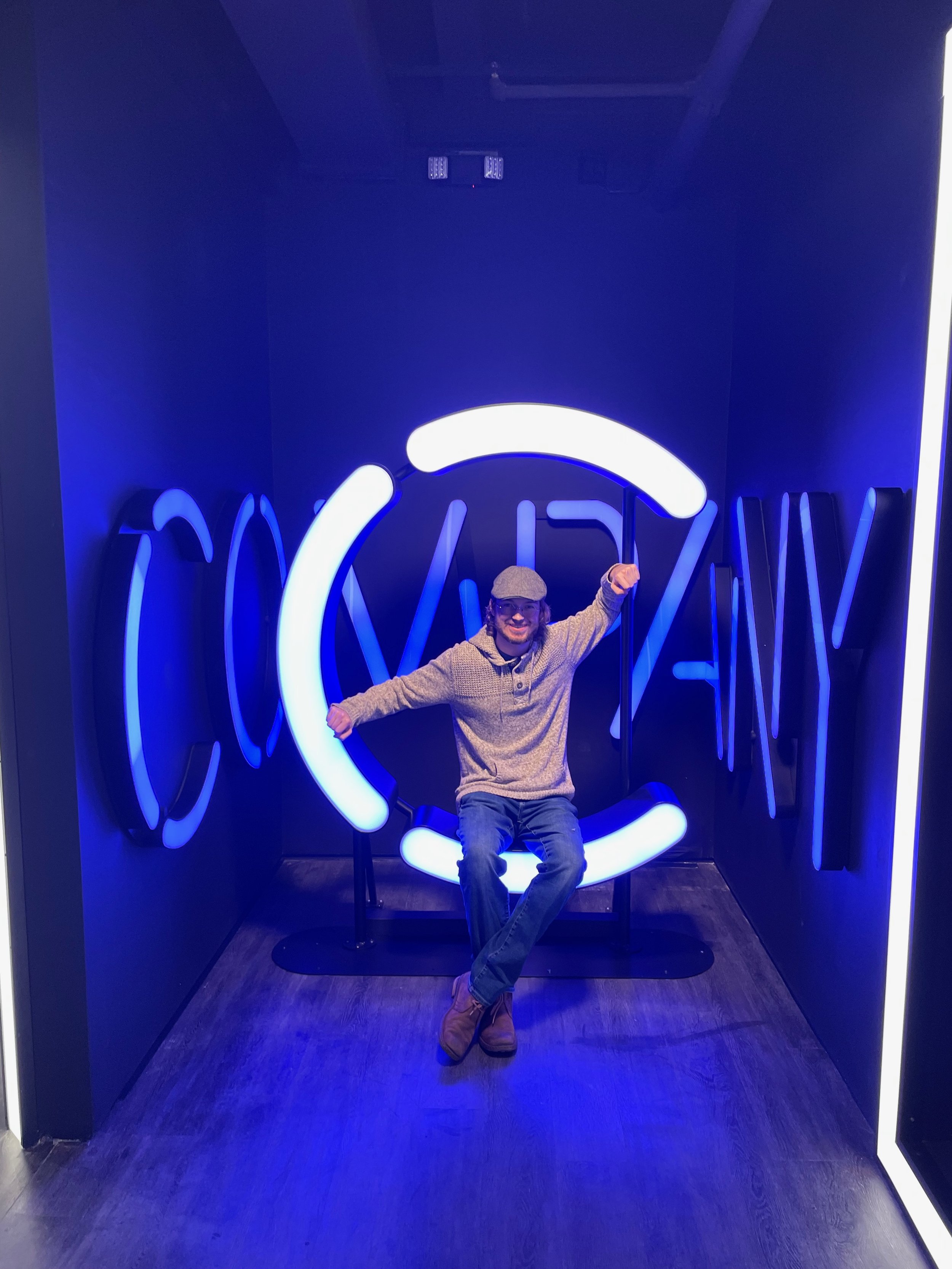Livin’ in New York City Post 14: A Festivus for the Rest of Us and Making Every Day Count
It’s beginning to look at lot like Christmas in my Bed-Stuy apartment.
Despite being roughly the same distance from the Equator, winter in NYC has surprisingly been more mild than expected. Keep in mind that I went to school about 60 miles from Chicago and would often dart through several academic buildings just so that I’d be warm on my way to class. Now that I’m essentially walking everywhere, I’ve found the cold of the city to be perfectly crisp but not like the chill of death the Midwest has to offer. But it’s Christmastime, my favorite time of the year and I was intent to celebrate it in style this holiday season.
First, I decided to get my very own Christmas tree. A real one. From a lot. Because of my brother’s allergies, I never had a real Christmas tree in my home. Granted, the plastic ones we’ve had are fantastic and I don’t harbor any feelings of resentment towards him (for that anyway), but I’ve always wanted a real tree. Plus, I don’t have the storage space to get a plastic tree.
Getting a real Christmas tree in New York has to be one of the easiest things you can possibly do, especially if you live in a smaller apartment like myself. I decided to go to the lot across the street from my job at the LIC Corner Café and get one of the smaller trees, only about three feet tall. Not only were the staff amazing, but I got a sizable discount on the tree. Why? Because I’ve been serving coffee to the guys that run the stand and, since I make an effort to know my regulars, I have reaped great rewards.
After getting the tree wrapped up, I carried it across my shoulders and took it on the subway for six stops until I got home. To be honest, my yuletide haul wasn’t even the strangest thing someone was carrying onto the train. That honor goes to some nutty lady who was carrying a chihuahua dressed up in an elf costume. Why must little dog owners take pleasure in torturing animals like this? Someone get Sarah McLachlan, she’s got an overtly sad song to sing. But I can proudly state that my home is looking a lot like Christmas with a beautiful tree covered in ornaments and twinkling lights.
While I’ve been meeting some new people in New York, it’s always great to see a familiar face from the Midwest. Earlier this month, John Weaver, my middle school principal and dear friend, paid me a visit at the café while he was visiting his daughter Jessica. Both Mr. Weaver and Jessica are why I have my jobs and I’m very grateful for that. Seeing him was fantastic because he reminded me where I came from and how, despite I’m so far away from home, it’s closer than I might realize.
A familiar face from Illinois! Thanks to John Weaver for checking in on me when he came to New York.
In New York, Christmas isn’t the only holiday that I’m celebrating this December. I also decided to partake in the rich tradition of Festivus. For those unaware of this grand holiday, watch the Season 9 episode of “Seinfeld” called “The Strike.” If you don’t want to watch “Seinfeld,” you owe me an apology but here’s a brief summary. In “Seinfeld,” George Costanza’s father hates all of the commercial and religious elements of Christmas so he made up his own holiday called Festivus. Instead of a tree, there’s an aluminum pole which requires no decoration because tinsel is distracting dammit. Also, at dinner, the head of the household angrily tells his family all of the ways they’ve disappointed him in “The Airing of Grievances” which is followed by “The Feats of Strength” which always ended with Geroge crying. Doesn’t that sound like a delightful holiday to celebrate?
While I wasn’t intent on replicating the episode of “Seinfeld,” I did want to celebrate the holidays with my friends in New York. But what do you do when two of your friends celebrate Christmas and the other celebrates Hannhakuh and you don’t want to call it a holiday party because then some braindead moron on FaceBook will think that you’re part of the mythical “War on Christmas” which is trying to purge Christianity from the country? You just call it Festivus.
I love Christmas and am proud of my Methodist upbringing, but I find that learning about other religions is fascinating. Since I live in a city that proudly celebrates religions of all sizes, I wanted to have some dishes at my Festivus party that reflected other faiths, specifically Judaism. I’ve always wanted to make brisket in the Jewish style and so, for Festivus, I decided to finally prepare this delicacy. I also wanted to have latkes and babka as well because those are some of the most delicious things that I’ve ever eaten. Unfortunately, I didn’t have the time nor the kitchen space to make brisket, lakes and babka all at once. I needed help which is why I ventured north to where Williamsburg and Bed-Stuy meet. It’s here that a strong Jewish community resides and I knew that I could find the culinary assistance I required.
When I made my way to this community, you could instantly feel the unity. I could have just taken a seat and watched this community interact, but I had a mission. After a bit of walking around, I found a place that could make amazing desserts: Green’s Bakery. While they don’t have any dine-in seating and work exclusively online, Green’s has a reputation for the best babka you’ll ever eat. So, I ordered two babkas, one chocolate and one cinnamon, as well as some black-and-white cookies which arrived at my apartment a few days later. For all of my Gentile brothers and sisters who don’t know what babka is, it’s a braided bread which has a sweet filling (usually chocolate or cinnamon) and it tastes amazing. Imagine the flaky warmth of a croissant mixed with divine sweet flavors.
Along with some latkes, which I ordered from Shelsky’s in Downtown Brooklyn, my Festivus dinner was coming to fruition. However, I knew that I had to make the brisket myself. But where to get this cut of beef? It’s not like you can just go to any deli and order one. You have to go to a butcher and not every butcher has brisket. After being told by my boss at the café that good butchers could be found in Williamsburg and Greenpoint, I spent an hour going from shop to shop looking for a brisket but to no avail. I saw a lot of cured meats, sausages, loins, hams, steaks and practically every other cut of beef, pork, lamb and veal but no brisket.
When I went to the Meat Hook in Williamsburg, I found that they did have brisket. Sadly, they were all on hold for Hannakuh which I consider to be fair. After all, the Jews have made great brisket for years so they obviously deserve first dibs. Meanwhile, I’m just a goye trying slow and low cooking for the first time. Suppose it’s terrible? I don’t know how I could go to a deli again.
Model T. Meats, a fantastic butcher shop where you can get one hell of a brisket.
Just when I felt like giving up, across the street was Model T. Meats which only accepted cash for their orders. To best paint a picture as to what the inside of this establishment looked like, imagine the meat locker from “Rocky” where the titular boxer was using sides of beef as punching bags. Everything about Model T. Meats reminded me of that. The butchers honestly reminded me of the Midwest, even though their Brooklyn accents were incredibly thick. When I asked for a flat cut of a brisket (roughly six pounds) and the butcher went to check his inventory, I was so happy when the apron clad master of meat came back with that elusive cut of beef. As he carved and took off the excessive fat, I began to salivate, my mind racing with all of the things I was going to do to that slab of meat. As I rode the train home, I felt such pride as I cradled the brisket, covered in wrappings in a plastic bag.
Cooking the brisket took hours as I had to make a sauce rich with sweet and sour elements like vinegar, tomatoes, ketchup, dijon mustard, honey, brown sugar, onions, carrots and celery. Following that, I had to nestle the browned brisket into this sauce where it cooked for four hours until it was a tender, rich masterpiece. After refrigerating it overnight, carving it and then reheating, my friends were treated to a Festivus feast of Jewish brisket, lakes and babka along with the Gentile classics of green bean casserole and cornbread. This brisket was easily one of the greatest things I’ve ever cooked and so rich in flavor.
As for the latkes, they were given a boost by a little something from home. Traditionally, latkes are eaten with either sour cream or applesauce. Since I detest sour cream and one of my friends is a self-professed “applesauce Jew,” what better way to eat latkes than with my Grandma’s homemade applesauce, which is the only kind of applesauce I can eat. Unlike store bought applesauce, which feels too solidilar and tastes too sweet, Grandma’s applesauce has more liquidity to it and also has some tart to it. After eating it on top of a latke, my friend, who’s Jewish, said that it was amazing. Congratulations Grandma! Your applesauce is latke-worthy.
Ladies and Gentlemen, one of the most delicious things I have ever cooked.
After my failed attempt to see the Rockefeller Tree Lighting ceremony, I decided to venture back into Midtown to see it in all of its glory. At 82 feet in height, this tree was unmistakably beautiful as it towered over everyone. When I came to see it, so many people were marveling at it but there wasn’t a feeling of claustrophobic mania. It was more subdued with everyone just wanting to take in the Christmas spirit. Across the street, at Saks, a massive lightshow was taking place every 15 minutes which saw all of the store’s Christmas lights become part of an extravaganza of music and perfectly timed exterior illumination. As I walked past Rockefeller Center, I saw NBC studios where they film many television shows, including “Saturday Night Live.” As I walked underneath the marquee, I just said to myself “one day.” Whether I’m an audience member or, maybe one day, a crew member, I want to see a live taping of “SNL.”
Midtown may be growing on me with all of its busy streets and brightly colored distractions, but my favorite spots in Manhattan are still on the southern side of the island (although I really need to check out Harlem in the new year). One day, after work at the café and going to see a movie, I decided to go down to Greenwich Village just to take in the serenity of New York’s cultural pulse at night.
I went to Strand Bookstore and bought the poetry book “Howl” by Allen Ginsberg, which I’ve always wanted to read because of its legendary status in the American counterculture. I walked to Washington Square Park and saw many people taking selfies with the Washington Square Arch, which you can see the Empire State Building through, and the Christmas tree that lay underneath it. As I watched these people enjoying such a beautiful sight, I sat on a bench and read all 20 pages of the poem. I was enthralled with every word. So much pain, vulgarity, protest all expressed in Ginsberg’s brilliant prose.
There was so much to take in that, as I finished the poem, I felt so emotional. But I couldn’t explain why I felt such attachment to “Howl.” Sitting on that bench, with the book in my hand, I could see my breath fogging up in front of me and felt the chill of winter. My legs were practically stuck to the bench. But I wasn’t finished. With my freezing fingers, I turned the pages back and read it again. And then again. And then again, only this time out loud. I wanted to understand everything. After five or six times, I finally discovered what the poem means to me.
In Washington Square Park, the atmosphere is still incredibly lively at the heart of Greenwich Village.
Starting with the famous line “I saw the best minds of my generation destroyed by madness,” Ginsberg writes on and on about the people he’s seen crushed in so many ways. As the poem goes on describing art and beauty at war with cold destruction, I felt that “Howl” was a eulogy for the artists that never made it. Allen Ginsberg took every fear and doubt I ever had and turned it into a 20 page epic that shook me and, I felt, made me far wiser. After my many readings, I pulled myself off the bench, then went to Joe’s for a slice of pizza. Afterwards, I went to the Groove where I listened to some good live music, danced and, in between drinks, kept thinking about all of the destroyed minds Ginsberg relayed to me.
The next day, I went up to Astoria, Queens to check out The Museum of the Moving Image, a place where you can see various exhibits about the history of cinema. Located right next to Kaufman-Astoria Studios, the only film studio in New York with a back lot, this place was made for me. One exhibit, which is available until the new year, was focused on the legendary Dan Perri. While he’s not a household name, Perri has made his mark on cinema by designing the opening credits of so many great films including “Star Wars,” “The Deer Hunter,” “Close Encounters of the Third Kind,” “A Nightmare on Elm Street” and several Martin Scorsese films.
I feel that audiences underestimate a good opening credits sequence and how they do such important work. Their whole goal is to get you excited for what you’re about to watch and to set the mood of the film. What would “Star Wars” be without its triumphant crawl? What would “The Last Waltz” be without its elegant credits which showcase all of the amazing musicians that took part in the film? What would “Caddyshack” be without that golf ball (which is the size of a grapefruit in real life) with the film’s title stamped on it?
The museum also has an entire floor dedicated to the history of film technology including cameras, machines for editing and sound design, lighting rigs and so many other industry tricks. Being surrounded by all of these machines made me feel like a kid in a candy store. I even felt the joy of the earliest devices which simulated moving pictures like an old nickelodeon which had a Charlie Chaplin film as well as a Zoetrope.
But the exhibit that I most enjoyed, and I suspect you will too, is the museum's permanent Jim Henson gallery, which showcased the history of Henson’s puppeteering and the influence of shows and films like “The Muppets,” “Sesame Street,” “Labyrinth,” “Dark Crystal,” and “Fraggle Rock.” Not only were there famous puppets like Kermit the Frog, Big Bird, Rowlf, Statler and Waldorf, Miss Piggy and Elmo, but you could even work with your own muppets. One part of the exhibit had a green screen and a camera where you could operate a muppet and crouch down to give you an idea of what it’s like to be one of the Henson puppeteers. There was also part of the museum where you could design a muppet with the velcro technology that the Jim Henson workshop uses.
At the Museum of the Moving Image, it was incredible to see one of Jim Henson’s Kermit puppets.
It wasn’t just Henson’s famous work that was on display, the museum also showed his humble origins like “Sam and Friends” and his commercials featuring the characters Wilkins and Wontkins. These commercials are some of the most fucked up advertisements you’ll see. The set up is basic: Wilkins wants Wontkins to try a product (usually Wilkins Coffee) and Wontkins refuses. So Wilkins mercilessly hurts him. Since these commercials were each about ten seconds long, the violence was quick and ruthless. I’ve seen commercials where Wontkins gets threatened, smashed, kicked and lit on fire. And those are just the commercials the museum showed. There are ones where he’s shot, stabbed, blown up and so many other horrific things.
Honestly, Wilkins is one of the most psychopathic characters I’ve ever seen on television. Currently, the Wilkins puppet at the Smithsonian and I hope they have him in a glass case with a muzzle on him like Hannibal Lecter in “Silence of the Lambs.” However, if you’re a huge fan of over-the-top slapstick violence like I am, these commercials are also really funny to watch. It may not be easy being green, but it’s easier than being friends with Wilkins.
But I wasn’t done experiencing movie history that day. I took a train from Queens to Greenwich Village so I could go see my favorite Christmas film, “It’s a Wonderful Life,” at the IFC Center. I made sure to get there early before the doors were even opened to us and I’ glad I did. When we entered the auditorium, the IFC Center played an episode of “The Donna Reed Show,” Season 1 Episode 14 to be exact, titled “A Very Merry Christmas.”
In the episode, Donna is worried that people have lost the Christmas spirit and that everyone has seemed to forget about throwing a Christmas party for the children in the ward of the hospital where her husband (Carl Betz) works. Fortunately, Donna is able to help the hospital’s kind janitor throw a Christmas party for the kids. He dresses up as Santa Claus and both he and Donna make sure the kids have a Merry Christmas. The janitor was played by screen legend Buster Keaton and the entire theater went nuts when we saw his name in the credits. It was so weird to see him in a talking role given his fame as an actor and filmmaker during the silent era of American cinema.
But what did I think of “The Donna Reed Show?” I think it's definitely a product of the times but it has a nostalgic charm that won me over. There’s a great episode of “Gilmore Girls” where Lorelei and Rory mock “The Donna Reed Show” and I’ll be damned if I didn’t hear a bunch of clever jokes by Lauren Graham and Alexis Bledel in the back of my mind lobbed toward this particular episode. As is, the episode was a great way to get into the Christmas spirit as well as become more acquainted with Donna Reed before seeing her as Mary Bailey in “It’s a Wonderful Life.”
But what was the point of showing us an episode of “The Donna Reed Show?” Was it just because they both had the same leading lady? Not exactly. Before the film started, a special guest came to talk to us about the legacy of “It’s a Wonderful Life:” Donna Reed’s daughter Mary Owen.
Mary Owen has been coming to the IFC Center every December since the theater started showing “It’s a Wonderful Life” to talk to us about the film’s impact on her mother and herself as well as share some stories about the Oscar-winning actor. Owen related to us so many entertaining stories about her mother and also talked to us about the Donna Reed Foundation, based in Reed’s hometown of Denison, Iowa, which supports youth performing arts as well as keeps Reed’s legacy alive through the Donna Reed Museum. So, next time I’m in Western Iowa, I know where I want to go.
While it would take me forever to detail all of the stories Owen told us, here are some of the best:
Everyone involved with the film was so disappointed that it didn’t make any money at the box office. Because of the film’s lack of success, it took decades before “It’s a Wonderful Life” became a Christmas classic thanks to television reruns. Owen didn’t even see the film until she was in college when her friends invited her to a screening at the local theater.
During filming, Lionel Barrymore, who played Mr. Potter in the film, didn't believe that Donna Reed came from a farm in Iowa. So, he bet a $50 war bond that she couldn’t milk a cow. Reed said it was the easiest money she ever made.
Donna Reed and Jimmy Stewart nailed one of the most intense scenes between them, the phone call to Sam Wainwright, in one take.
Not only did Donna Reed star in her television show, she created it with her husband Tony Owen and was involved in many creative decisions. One of those was the casting of Jimmy Hawkins, who played one of George and Marey Bailey’s children in “It’s a Wonderful Life,” in a recurring role. When Hawkins asked if Reed remembered him, she said yes. The cast nicknamed him “Rip Van Winkle” because he would sleep in between takes.
From the time Donna Reed was 13 until her death in 1986, she wrote letters to her pen pal Violet Lindsay. After Lindsay’s death a couple of years ago, the letters became part of the Donna Reed Museum. In these letters, Reed wrote that she thought “It’s a Wonderful Life” might be her big break. She also swooned to Lindsay about meeting Clark Gable and being asked out on a date by Mickey Rooney. Reed told Rooney that she wasn’t available that night.
Mary Owen read some of the letters Reed received from soldiers in WWII where they said that she was their favorite actress.
While most of the film was shot on the back lot of RKO with the town of Bedford Falls being one massive set, there were some locations that were leased for production. One of them was Beverly Hills High School where the gym was used for the famous scene where George and Mary dance before falling into the swimming pool underneath the gym floor. Mary Owen went to Beverly Hills High School and played basketball and swam in that pool. That’s got to be a weird feeling.
Donna Reed may have been disappointed that “It’s a Wonderful Life” wasn't a hit, but she did get to see it become a believed holiday classic and was very happy with that.
During the Q&A, I asked Mary Owen when she became aware that the film was a Christmas classic since it took decades for it to become popular. She said she realized it when she first started coming to the IFC Center and told her stories about her mother. The first screening of the film the IFC Center hosted was to an audience of four people and now the auditorium was full which filled her with joy.
I had never seen “It’s a Wonderful Life” on the big screen before and it warmed my heart like it does every time I watch it. However, seeing it with other people, many of whom were watching the film for the first time, was a whole new experience as we all laughed, cried and experienced the film’s magic together. How can you not feel the love of the holidays when watching “It’s a Wonderful Life?” Especially that ending.
Before heading home for the holidays, I wanted to make sure that I made the most of my final days in New York so I decided to check out a Broadway show since the last one I saw was “Mr. Saturday Night” back in September. However, I didn’t see a musical this time. I saw Arthur Miller’s “Death of a Salesman” before it closed next month. While many people had to read the play in high school, I hadn’t. My school’s Arthur Miller selection was “The Crucible,” which I loved. I had a vague idea of what the show was about but I was walking into this performance practically blind.
Set in Brooklyn in the late 1940s, the play tells the story of the crumbling Loman family as the patriarch, Willy (Wendell Pierce), ponders his past mistakes, where his life is going and his relationships with his wife Linda (Sharon D. Clarke) and his sons Biff and Happy (Khris Davis and McKinley Belcher III) as he slips into madness. The play has long been praised for its depiction of the dark truth behind the American Dream, its realistic family drama and how well Willy’s mental spiral is depicted.
However, what made this production so unique was that, for the first time on Broadway, the Lomans were depicted as a black family. Not only does this make for a welcome change, but it also adds a whole new layer to the drama. Not only is class an issue with Willy as he wants to be more than what he is, but now race is too. When Willy talks to his boss Howard (Blake DeLong) about getting a better job with the company after decades of service and Howard fires him, it’s not just a rich man casting aside a poor man. It’s a white man in power casting aside a hard working black man in an all too familiar example of racial prejudice.
Wendell Pierce was so magnificent as Willy Loman and gave such a deeply human performance. His declining mental state brought tears to my eyes several times as did everyone’s performances as a deeply broken family. Pierce reprised his role from a West End production of “Death of a Salesman” in London and I hope this role gets him a Tony Award. The legendary André de Shields also was in the production as Willy’s deceased older brother Ben, who Willy frequently sees and asks for help. I had no idea the Tony-winning actor was in this production so I was simultaneously elated and awe-struck. While the musical side of Broadway is fun, I really need to see more plays because this was a marvelous experience.
During the intermission, a bunch of people that were seated by me left. Not because they hated the show but because they had other things to do. So let me get this straight. You paid good money to watch one of the great American plays with a superb cast just a few weeks before it closes and it’s not enough? I think I speak for the ghost of Arthur Miller when I say this. Go to the Empire State Building and fuck all the way off it you little shits. How could you leave? This was a masterclass of acting, set design, atmosphere and drama and you just decided that you could do better? What the hell is wrong with you? Oh well, at least the row I was in got a bit more roomy.
While I certainly have seen a lot of great things recently, I was looking forward to seeing Billy Joel live at Madison Square Garden. I bought the tickets a few months ago and I was pumped out of my mind for my first trip to the world’s greatest arena with one of my favorite artists. Unfortunately, Billy Joel caught a viral infection which required him to postpone the concert to June. While I was very disappointed, I understood. You want Billy Joel to be healthy and to sound his best. Plus, it’s not like I’m not going to be here this summer. I will survive and, come June, I will be there at MSG to see the Piano Man play his heart out.
Among the set replicas in the Museum of Broadway was Doc’s Drugstore from “West Side Story.”
But what was I to do that day? I had my entire schedule cleared so I could see that concert. Instead of moping, I decided to make it a fun day nonetheless. So, I went to the Museum of Broadway which just opened this fall. With all sorts of interactive exhibits dedicated to how a show is put together, the most famous faces in Broadway’s history and some of the greatest shows ever performed, it’s definitely one of those essential places to visit. As much as I hate Times Square, it’s worth braving for the sake of theatre. Among the exhibits were a replica of Doc’s drugstore from “West Side Story,” The Kit Kat Klub from “Cabaret,” Bobby’s apartment from “Company” and The East Village from “Rent.” If you’re a fan of Broadway, you’ll love it. If you’re curious about the history of New York theatre, you’ll also be a fan of this place.
Following that, I also wanted to see a movie at the Alamo Drafthouse, one of my favorite theaters, in the Financial District before I went home for the holidays. But what to see? Why “The Fabelmans,” of course. My favorite film of the year, I have now seen it four times in the theater and I hope to see it even more. The fact that this film bombed at the box office saddens me but I still loved seeing “The Fabelmans” with an enthusiastic audience.
I got there very early and saw the the Alamo Drafthouse was showing old trailers and advertisements that connected directly to the film including a trailer for Cecil B. Demille’s “The Greatest Show on Earth” (the first film that Sammy Fabelman’s parents take him to see), advertisements for the cameras Sammy used and a trailer for “The Man Who Shot Liberty Valance” (a film that heavily inspired Sammy and was directed by John Ford, who Sammy meets at the end of the film). That’s what I love about the Alamo Drafthouse. They don’t just show movies, they take you on an experience. They understand the cinephile and cater to them as well as make every showing unforgettable. Plus they have a bar and dinner menu that gives you food during the film. So that’s cool.
As of when this blog entry is published, I’m currently packing because, on Wednesday December 21, I will be flying out of LaGuardia Airport for O’Hare. So prepare yourself Illinois. I’m coming home.
My favorite part of the museum was the exhibit dedicated to “Company,” the first show I ever saw on Broadway.


